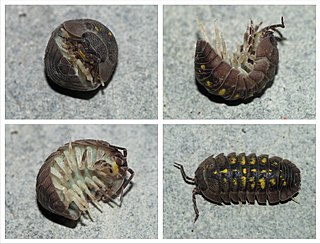
Armadillidium is a genus of the small terrestrial crustacean known as the woodlouse. Armadillidium are also commonly known as pill woodlice, leg pebbles, pill bugs, roly-poly, or potato bugs, and are often confused with pill millipedes such as Glomeris marginata. They are characterised by their ability to roll into a ball ("volvation") when disturbed.

Porcellio scaber, is a species of woodlouse native to Europe but with a cosmopolitan distribution. They are often found in large numbers in most regions, with many species preying on them.

Oniscus asellus, the common woodlouse, or common shiny woodlouse is one of the largest and most common species of woodlouse native to the British Isles and Western and Northern Europe, growing to lengths of 16 mm and widths of 6 mm.
Calconiscellus is a genus of crustacean in family Trichoniscidae. One species, C. gotscheensis, is listed as vulnerable on the IUCN Red List.
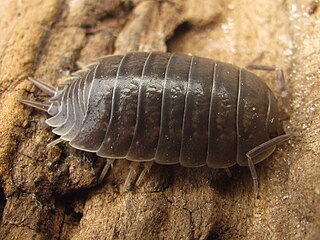
Porcellio laevis is a species of woodlouse in the genus Porcellio. As the species epithet laevis as well as the vernacular name "swift woodlouse" suggests, the species is capable of quick bursts of speed when provoked.
Trichorhina mulaiki is a species of woodlouse in the family Platyarthridae.

Trichoniscidae are a family of isopods (woodlice), including the most abundant British woodlouse, Trichoniscus pusillus. Most species of woodlice that have returned to an aquatic or amphibian way of life belong to this family. Several species from the following genera live in water and on land: Titanethes, Cyphonetes, Alpioniscus, Scotoniscus, Bureschia, Brackenridgia, Mexiconiscus, Trichoniscoides, Cretoniscellus, Balearonethes and Cyphoniscellus.

Woodlice or roly-polies, are terrestrial isopods in the suborder Oniscidea. Their name is derived from being often found in old wood, and from louse, a parasitic insect, although woodlice are neither parasitic nor insects.

Trichoniscus pusillus, sometimes called the common pygmy woodlouse, is one of the five most common species of woodlice in the British Isles. It is acknowledged to be the most abundant terrestrial isopod in Britain. It is found commonly across Europe north of the Alps, and has been introduced to Madeira, the Azores and North America.

Hyloniscus riparius is a species of woodlouse found in Central and Eastern Europe and subsequently introduced to North America. It is strongly associated with flood plains and can tolerate periods of up to eight weeks submerged under water. In North America, it was first found at St. John's, Newfoundland in 1951, and later in New York, New Jersey, Pennsylvania and North Carolina.

Armadillidium pictum is a species of woodlouse which occurs over most of Europe, except the Mediterranean Basin and Southeast Europe. In the British Isles, it is only known from a few sites, making it by some accounts, "Britain's rarest woodlouse". Since these sites are all remote from human habitation, in Cumbria and Powys, the species is thought to be native rather than introduced.

Mesoniscus is a genus of woodlice, placed in its own family, Mesoniscidae, and section, Microcheta. It contains two species – Mesoniscus alpicolus and Mesoniscus graniger – that live in Central and Eastern Europe, mostly in and around caves.
Trachelipus gagriensis is a species of woodlouse in the genus Trachelipus belonging to the family Trachelipodidae that can be found in Ukraine and Georgia.
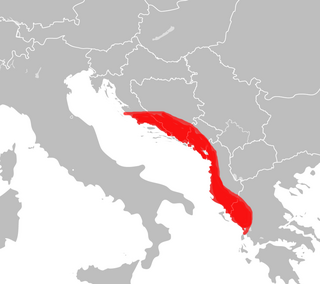
Armadillidium klugii is a lesser-known, rare Balkan, Dalmatia-based species of woodlouse, most distinguished by its colouration which resembles the red markings of the Mediterranean black widow Latrodectus tredecimguttatus. This is probably a kind of mimicry, to ward off predators that mistake the harmless animal for a venomous spider.

Armadillidium nasatum, the nosy pill woodlouse, is a large, Western European-based species of woodlouse that has been introduced to North America, along with Armadillidium vulgare also found in other parts of Europe.

Helleria brevicornis, the sole species of the monotypic genus Helleria, is a terrestrial woodlouse endemic to the islands and coastal regions of the northern Tyrrhenian sea. H. brevicornis is of interest due to its endemism, unique ecology and basal position in the suborder Oniscidea.
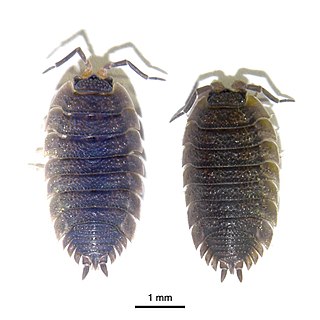
Iridovirus armadillidium1, known formerly as Invertebrate iridescent virus 31 (IIV-31) and informally as isopod iridovirus, is a species of invertebrate iridescent virus in the genus Iridovirus. Oniscidea serve as hosts. Infection is associated with decreased responsiveness in the host, increased mortality and the emergence of an iridescent blue or bluish-purple colour due to the reflection of light off a paracrystalline arrangement of virions within the tissues.

Hyloniscus is a genus of woodlice belonging to the family Trichoniscidae. Its members are found across Europe and North America.
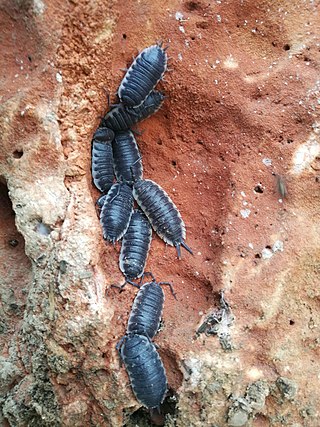
Porcellio hoffmannseggii, commonly called the titan isopod, is a species of woodlouse of the genus Porcellio described in 1833. This very large species is native to the southern Iberian Peninsula, Morocco and the Balearic Islands.















